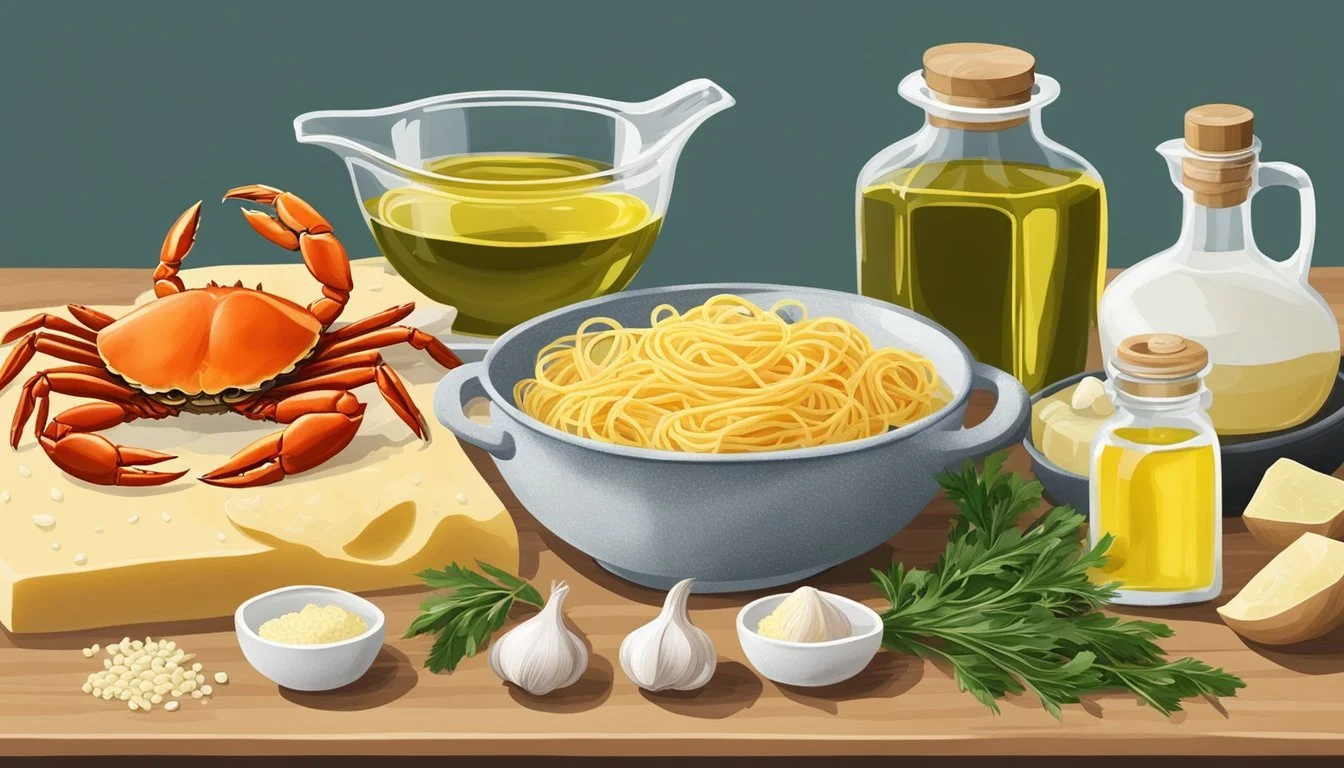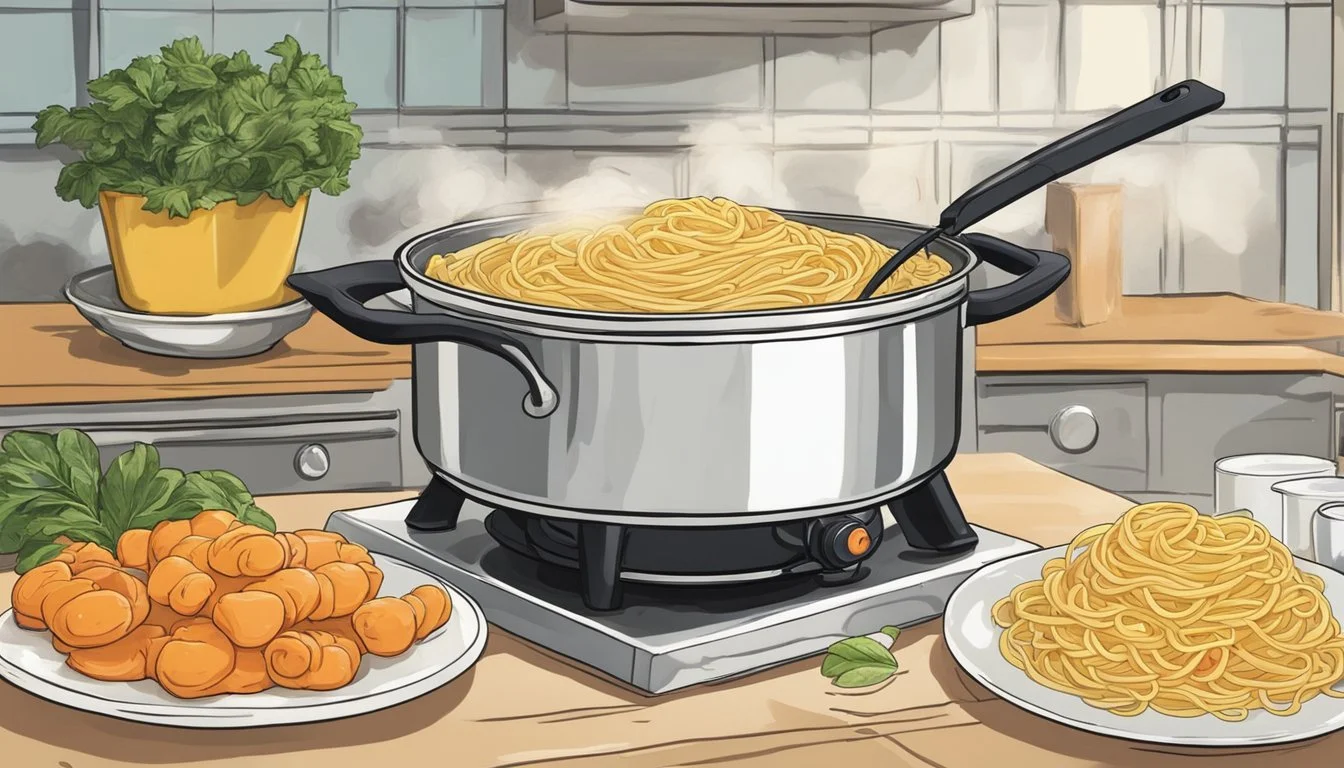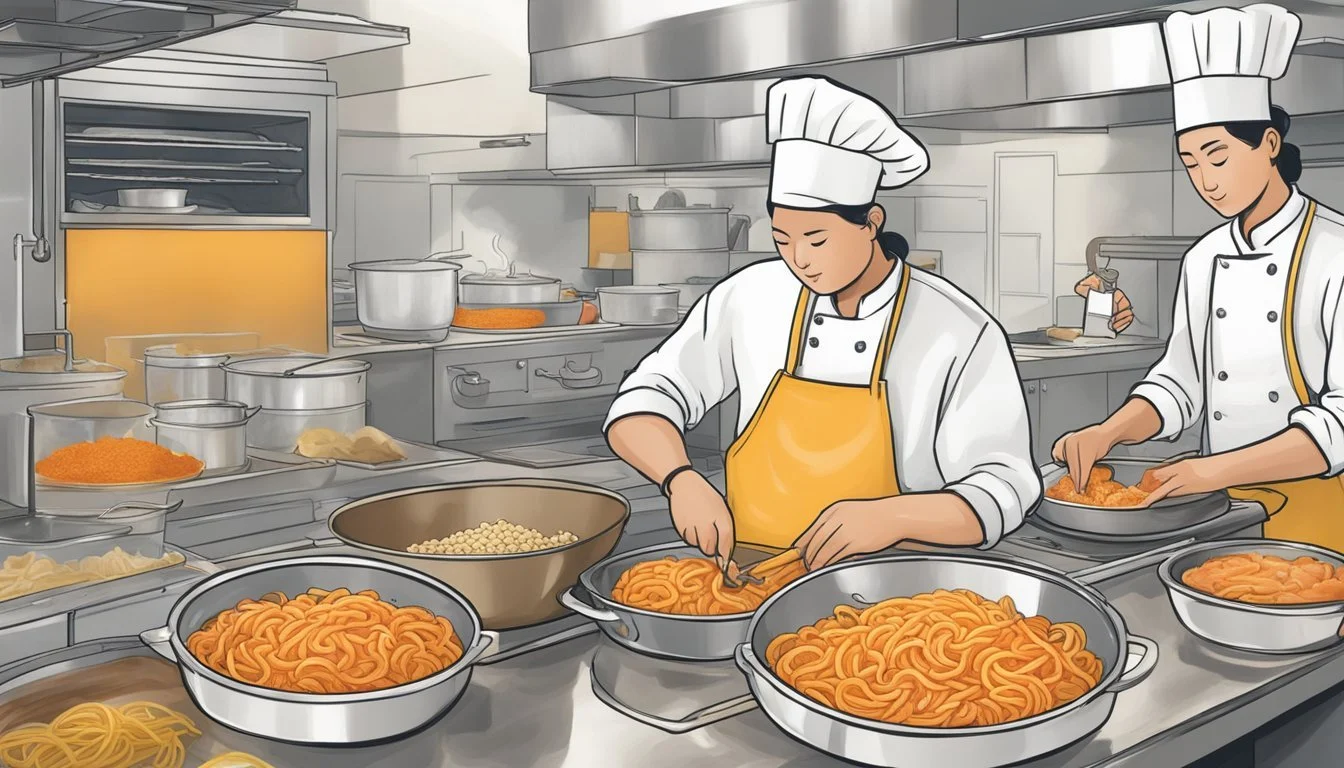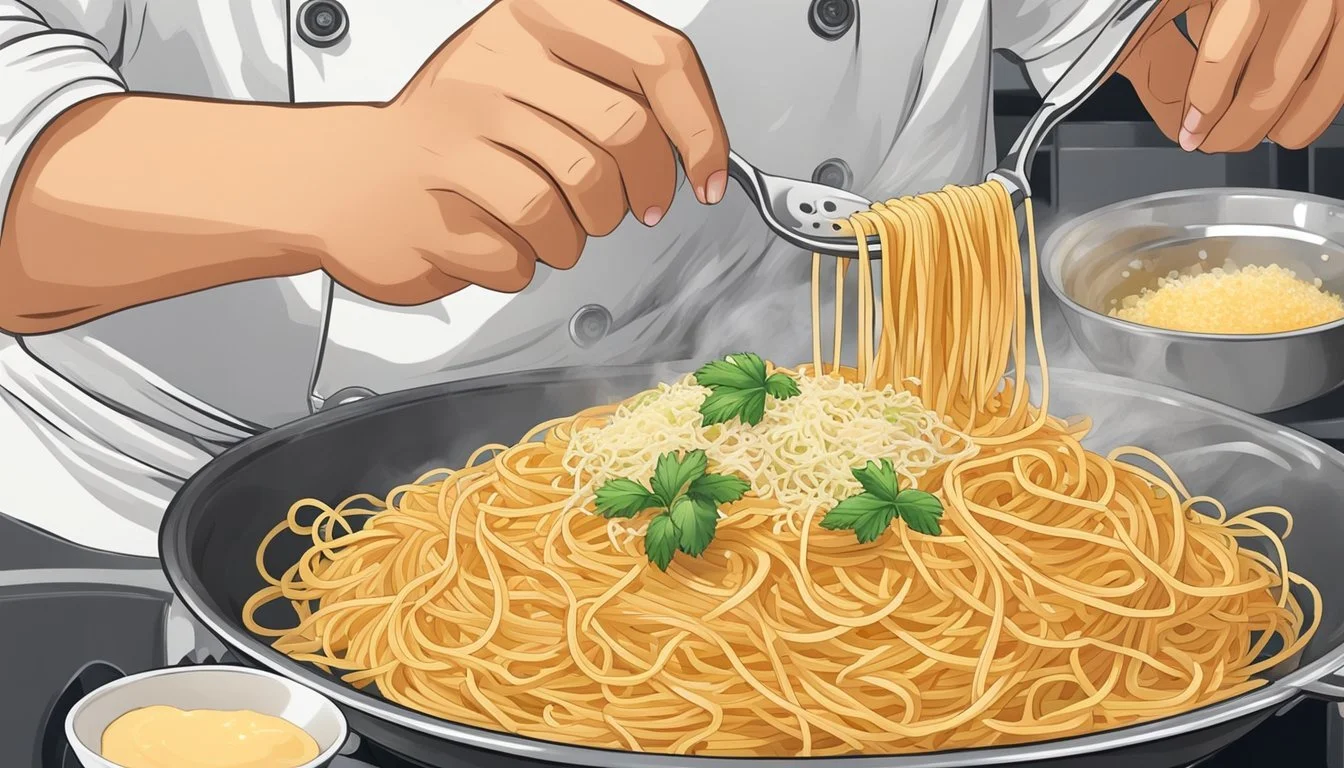How to Make Luxurious Crab Roe Pasta Sauce from Scratch
A Gourmet Guide
The allure of a luxurious crab roe pasta sauce lies in its rich flavors and elegant presentation. Such a dish epitomizes the fusion of simplicity and sophistication. Making this sauce from scratch requires careful selection of the finest ingredients to enhance the natural delicacy of the crab roe. The fusion of the roe's briny taste with a selection of harmonious seasonings transforms the ordinary into a gourmet experience. Pasta (What wine goes well with pasta?) cloaked in this sumptuous sauce captures both the essence and opulence of a carefully crafted culinary creation.
A confident home chef knows that the secret to a memorable crab roe pasta sauce is not just in the roe itself but also in the precise cooking techniques. Sautéing ingredients over the right amount of heat, timing the simmering of the sauce to perfection, and knowing just when to combine the elements contribute to the success of the dish. Each step is crucial to unlocking the full potential of the flavors while ensuring the delicate crab roe remains the star of the sauce.
With a methodical approach, one can prepare a crab roe pasta sauce that is both indulgent and poised, making any dining table it graces feel like a celebration of the sea. It's a sauce that promises to leave diners not just satiated but impressed, confidently asserting itself as a staple for those who revel in the luxury of a well-made pasta dish.
Gathering Ingredients
Before creating a luxurious crab roe pasta sauce, one must curate high-quality ingredients that will elevate the flavor profile of the dish. Selecting the right type of crab meat and pasta, along with fresh herbs and seasonings, is crucial for achieving a gourmet experience.
Selecting the Crab Meat
The choice of crab meat is pivotal for the sauce's flavor and character. Sweet crab meat varieties such as jumbo lump crab meat or lump crab meat are preferable for their delicate texture and rich taste. When available, opt for fresh crab meat from blue crabs or whole crabs to ensure the sweetness and quality of the sauce.
Choice of Pasta
The pasta serves as the foundation for your sauce and should complement the delicate crab flavor. Long, flat pasta shapes such as spaghetti, linguine, or fettuccine are ideal for clinging to the sauce. Ensure the pasta is of high quality—preferably bronze-cut to better hold the sauce.
Herbs and Seasonings
To enhance the crab roe sauce, a careful selection of herbs and spices is necessary:
Olive oil: Use extra-virgin olive oil for its fruity notes that will not overpower the crab.
Garlic: Fresh garlic is essential for its aromatic qualities.
Parsley: Fresh parsley should be chosen for its bright, herbaceous lift.
Lemon: Incorporate both lemon zest and juice for a zesty contrast to the sweet crab.
Seasonings should include kosher salt for its clean, coarse texture, freshly ground black pepper, and a pinch of red pepper flakes for subtle warmth.
Preparing the Pasta
Perfectly al dente pasta not only complements the luxurious crab roe sauce but also acts as a foundation for the dish. Cooking pasta to just the right texture requires attention to detail and timing.
Cooking Pasta to Al Dente
One begins by bringing a large pot of water to a boiling state. For every pound of pasta, typically 4 quarts (16 cups) of water is recommended. Once boiling, it is important to add a liberal amount of salt, usually about 1½ tablespoons, to flavor the pasta as it cooks. The choice of pasta—be it spaghetti, linguine, or fettuccine—should then be added to the pot. It is essential to stir the pasta frequently to prevent it from sticking together.
For perfect al dente texture, the pasta should be cooked according to the package instructions but stopped about 1 minute short. This ensures that the pasta maintains a slight resistance or 'bite' when tasted. The exact cooking time will vary depending on the pasta type and thickness.
Reserving Pasta Water
Before draining the cooked pasta, one should reserve about 1 cup of the pasta water. This starchy water is a crucial component for the sauce as it helps in emulsifying and thickening, thereby ensuring a silky texture that adheres well to the pasta. To reserve, simply use a cup or heat-proof measuring container to scoop out the water from the pot, or if possible, place a colander over a large container to catch the water as the pasta drains. This reserved pasta water can be slowly mixed into the crab roe sauce to reach the desired consistency.
Making the Crab Roe Sauce
Creating a crab roe pasta sauce from scratch involves a careful balance of flavors and techniques. This section will guide the reader through establishing a flavorful base and incorporating seafood (What wine goes well with seafood?) for a luxurious sauce.
Creating the Base
The foundation of any robust sauce starts with high-quality oil or butter. One heats a pan to a medium setting and begins by sautéing finely chopped garlic in olive oil or butter to release its aroma. To this, one might add white wine, letting it simmer and reduce to intensify the flavor. The base evolves with the addition of a tomato sauce or cream—depending on preference for a tomato-based or creamy sauce. Using heavy cream can impart a rich texture and depth. These ingredients form a cohesive base, setting the stage for the infusion of seafood.
Incorporating the Seafood
Once the sauce base has achieved the right consistency, it is time to enhance it with the star ingredient—crab roe. The crab roe is gently stirred into the sauce, imparting a sweet and umami flavor profile that is distinctively seafood. This is also an opportune moment to incorporate other seafood such as shelled shrimp or lump crab meat, ensuring they are cooked just enough to be tender and flavorful. A gentle heat is essential during this process to avoid overcooking the delicate seafood while allowing their flavors to meld into the sauce, creating a truly luxurious and flavorful crab roe pasta sauce.
Combining the Elements
The integration of well-cooked pasta and a luxurious crab roe sauce is key to creating a dish that embodies fresh flavor with a bright and enticing taste profile. This section examines how to effectively combine these elements, ensuring they complement each other to enhance the overall dining experience.
Integrating Pasta and Sauce
Once the pasta is cooked to just before al dente, it should be transferred to the pan containing the crab roe sauce. Ideally, a small amount of pasta water can be used to adjust the consistency of the sauce, binding it to the pasta to create a coherent dish. The starch from the pasta water helps emulsify the sauce, ensuring it coats the pasta thoroughly. During this process, a gentle sautéing action helps to marry the pasta with the sauce for a unified taste.
Ingredients needed:
Reserved pasta water
Cooked pasta
Crab roe sauce
Steps:
Reserve a cup of the pasta water before draining the pasta.
Add cooked pasta to the sauce, tossing gently.
Gradually pour in reserved pasta water to achieve desired sauce consistency.
Adding Final Touches
A successful crab pasta dish is accentuated by final touches that introduce fresh and aromatic components. Once the pasta has been plated, a final drizzle of high-quality olive oil or a squeeze of lemon juice can be added to elevate the flavor. These final additions should subtly enhance the luxurious crab roe sauce without overwhelming it, leaving each plate with a fresh and vibrant taste.
Final touches to consider:
A drizzle of olive oil
A squeeze of lemon juice
Freshly cracked black pepper
A garnish of fresh herbs
The diner is left with a dish that not only looks appealing but provides a delightful combination of textures and flavors, marking the epitome of a well-executed crab pasta.
Presentation and Garnishing
The right presentation and garnishing transform a luxurious crab roe pasta sauce into a visual and culinary delight. Thoughtful plating and selected garnishes ensure each dish is as appealing to the eyes as it is to the palate.
Serving Suggestions
When serving crab roe pasta, one should opt for a flat, wide-rimmed plate to showcase the dish's components. A generous portion of the pasta can be twirled into a nest at the center, creating a nest-like structure to cradle the luxurious crab roe sauce. Spoon the sauce over the pasta, allowing it to pool slightly around the nest for an impressive display. A sprinkle of grated Parmesan cheese can add a touch of elegance as well as a salty, umami flavor that complements the sweet crab.
Garnish Options
Garnishing is the final step that elevates the pasta dish. Various ingredients can be used, but there are two favorites that not only enhance the flavor but also add a splash of color:
Parsley: A sprinkle of finely chopped fresh parsley adds a fresh, herbal note, and its vibrant green color stands out against the creamy sauce.
Lemon Zest: Lightly scattered over the dish, lemon zest offers a citrusy aroma which contrasts beautifully with the sweetness of the crab. It makes the flavors pop and adds brightness to the dish.
For those seeking a more substantial garnish, adding a crown of tender lump crab meat or jumbo lump crab meat to the top of the dish weaves in a succulent texture and reinforces the crab flavor throughout. It's essential to ensure that the crab meat is minced or chopped just enough to complement the dish without overpowering the delicate pasta.
Pairing and Serving
The right wine can elevate the subtle flavors of crab roe pasta sauce, while the appropriate side dishes can make it a meal to remember. A thoughtful pairing ensures that each element complements the next, providing a harmonious dining experience.
Wine Pairing
Selecting a white wine that balances the richness of crab roe pasta is crucial. Two excellent choices are:
Pinot Grigio: Its crisp and refreshing profile cuts through the sauce’s decadence.
Sauvignon Blanc: This wine brings a bright acidity that pairs well with the sweet crabmeat.
Both options highlight the luxuriousness of the pasta without overwhelming its delicate flavors.
Side Dishes
Pairing the pasta with side dishes should be done with care to maintain balance in the meal. Here are a few suggestions that harmonize with the luxurious nature of crab roe pasta sauce:
A simple green salad dressed with a light vinaigrette
Steamed asparagus with a squeeze of lemon to add a fresh, citrusy counterpoint
Garlic or herb-infused breadsticks that can double as a utensil for savoring every last bit of sauce
Combining these side dishes with the pasta creates a well-rounded presentation that enhances the overall experience.
Nutritional Information
When preparing Crab Roe Pasta Sauce from scratch, the nutritional profile can be highly beneficial when consumed in moderation. It is important to note that the nutritional content can vary based on the ingredients used and portion sizes.
Calories: The calorie content primarily depends on the amount of crab roe and pasta used. A typical serving of the sauce with pasta can range from 400 to 600 calories.
Nutrition: Crab roe is rich in proteins and omega-3 fatty acids, which are essential for heart health. The use of olive oil contributes healthy monounsaturated fats to the dish.
Dietary Considerations: For those monitoring their intake, opting for whole wheat pasta can increase the dietary fiber content, which aids in digestion and provides a more sustained energy release. Moreover, the sauce can be adjusted to accommodate dietary restrictions, such as using gluten-free pasta or a lighter version by reducing the amount of oil.
Here is a breakdown of the approximate nutrition facts per serving:
Nutrient Amount per serving Calories 500 kcal Total Fat 20 g Saturated Fat 3 g Cholesterol 60 mg Sodium 500 mg Total Carbohydrates 60 g Dietary Fiber 4 g Sugars 4 g Protein 25 g Omega-3 Fatty Acids 250 mg
This sauce can be part of a balanced diet when paired with a generous serving of vegetables and mindful of portion control. Choosing high-quality ingredients ensures the dish remains both a luxurious treat and a healthy choice.
Social Sharing
When sharing your luxurious crab roe pasta sauce on social media, it's crucial to adapt your strategies to the platform you're using. High-quality images, the right hashtags, and engaging captions can turn a post into a sensation.
Instagram and Facebook Tips
On Instagram and Facebook, visuals are key. A chef should:
Post high-resolution photos of the crab roe pasta sauce to entice their audience.
Use relevant hashtags like
#CrabRoePasta,#GourmetCooking, and#Foodieto reach a wider audience.
For Facebook specifically:
One can create a step-by-step image carousel showcasing the sauce preparation process.
Engage with the community by asking followers to share their own crab roe pasta sauce variations.
Pinterest Strategies
For Pinterest, detailed pin descriptions can increase visibility:
Create vertical pins with text overlays to explain the dish.
Write informative descriptions utilizing keywords related to crab roe pasta sauce, luxury cuisine, and pasta recipes.
Understand that each platform has unique algorithms:
For Pinterest, regular pinning is essential as it prefers frequent and consistent content sharing.
Content should be tailored to cater to individuals seeking culinary inspiration or luxury cooking methods.
Tips for Perfecting the Recipe
Crafting a luxurious crab roe pasta sauce is an art form that balances flavor and technique. Precision in preparation and an understanding of how to overcome common kitchen challenges are essential for a perfect sauce.
Expert Techniques
Optimal Oil Temperature: To begin, one must select the right oil. Extra virgin olive oil is often the best for its flavor and health benefits. Heat the oil until it's hot but not smoking. This is the ideal point for sautéing garlic until it's fragrant but not burnt.
Garlic Preparation: Whether one chooses to chop or mince the garlic can affect the intensity of flavor. Minced garlic becomes more fragrant and integrates quicker into the sauce. Chop the garlic if a more subtle garlic presence is desired.
Seasoning: Add salt and pepper at different stages. Salt early to enhance the flavors of the ingredients as they cook, and finish with a final seasoning for balance.
Troubleshooting Common Issues
Preventing Burnt Garlic: Garlic must be watched closely. If it's added to oil that's too hot, it will burn and become bitter. One should start with a medium heat and adjust as necessary.
Oil and Butter Balance: Balancing oil and butter provides flavor and a velvety texture without overpowering the delicate crab roe. If the sauce is too oily, one can emulsify with a little pasta water.
Consistency Corrections: If the sauce is too thick, ladle in small amounts of reserved pasta water to reach the desired consistency. Conversely, if too thin, one can simmer to reduce it slightly, constantly stirring to prevent sticking.
Understanding Seafood Sustainability
When making crab roe pasta sauce, the sustainability of the seafood used is crucial to the health of ocean ecosystems and the future of culinary enjoyment.
Choosing Sustainable Seafood
Sustainable seafood is sourced from fisheries or farms with practices that maintain or improve the population of the species and the well-being of the oceans. Consumers are advised to:
Research: Check for seafood certifications and labels that indicate responsible practices.
Ask Vendors: Question suppliers about the origin of their seafood.
Seasonality: Purchase seafood during the appropriate seasons to avoid supporting overfishing.
Budget-Friendly Tips:
Buy Local: Often less expensive and supports local communities.
Choose Lesser-Known Species: These are typically more abundant and less pricey.
Impact on Ocean Life
The impact of seafood consumption on ocean life is profound:
Habitat Destruction: Non-sustainable practices can destroy coral reefs and seafloor habitats.
Bycatch: Unintentional capture of non-target species during fishing can deplete populations and disrupt ecosystems.
Entertainment and Sustainability: When hosting, inform guests about the efforts taken to choose sustainable ingredients. This subtly educates and encourages responsible consumption.
Frequently Asked Questions
What is the best type of crab for making crab roe pasta sauce?
Snow crab is often recommended due to its sweet flavor and availability. The roe from snow crabs can add a rich and elegant touch to the pasta sauce.
How long does it take to cook the pasta sauce?
The sauce typically requires simmering for approximately 10 minutes to thicken after the tomatoes are added.
Is it necessary to use fresh tomatoes?
While fresh tomatoes can enhance the sauce, one can also use canned tomatoes for convenience without significantly compromising the taste.
Can I use onion instead of shallots?
Yes, though shallots provide a milder and somewhat more sophisticated flavor, one can substitute them with finely chopped onions if preferred.
What seasonings should be added to the crab roe pasta sauce?
Incorporate garlic, black pepper, and other preferred herbs for a deep flavor profile. One can also add red pepper flakes for a touch of heat.
Is making crab roe pasta sauce budget-friendly?
While crab roe is a delicacy, one can create a budget-friendly version by limiting the quantity used or using it in combination with other ingredients to extend the sauce.
What's the proper way to store leftover sauce?
The sauce should be cooled to room temperature and stored in an airtight container in the refrigerator. It's best consumed within two days.
Can this dish be served in a restaurant setting?
Absolutely. Crab roe pasta sauce is luxurious and can complement an elegant restaurant menu, especially when served over finely cooked pasta.
Conclusion
Crafting a luxurious crab roe pasta sauce from scratch can elevate a simple meal to a gourmet dining experience. Those armed with the right knowledge and quality ingredients can confidently execute this recipe, resulting in a dish that is both rich in flavor and visually appealing.
The process involves a delicate balance of flavors, achieved through the careful sautéing of garlic, olive oil, and red pepper flakes. The unique and indulgent flavor profile of crab roe, with its briny taste and creamy texture, brings a level of sophistication. The sauce's texture is further refined by simmering the ingredients to reduce and thicken the mixture.
When making this pasta sauce, chefs should remain attentive to details such as seasoning the pasta water properly and cooking the pasta to just shy of al dente. Reserve a cup of the pasta cooking water to adjust the sauce to the perfect consistency.
Tips for Success:
Use high-quality, fresh crab roe for the best flavor.
Simmer the sauce uncovered to concentrate the flavors.
Stir the pasta frequently while boiling to avoid sticking.
By following these guidelines, one can create a dish that is sure to impress, making any dinner occasion feel more special. This rewarding process not only showcases a chef's culinary skills but also enhances the dining experience with a touch of luxury.








